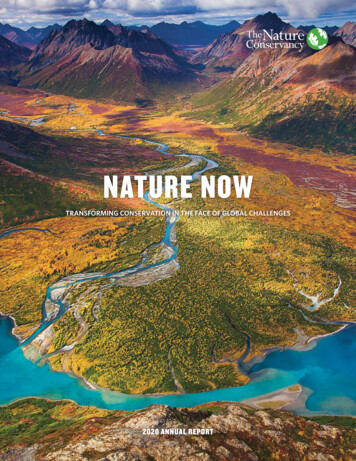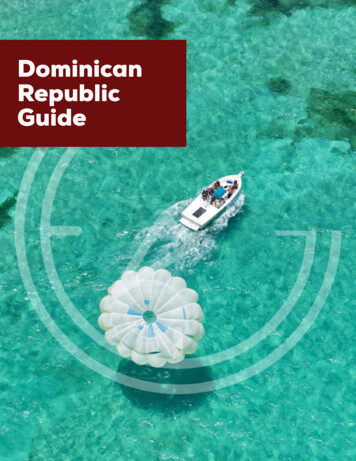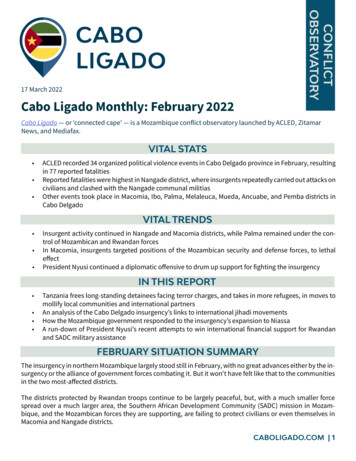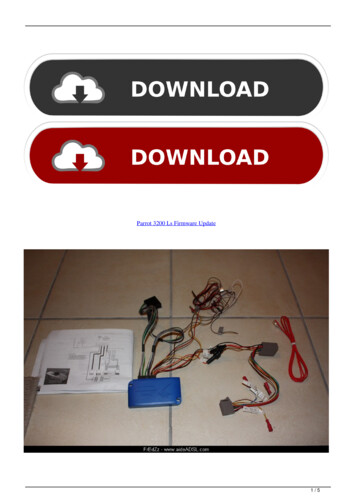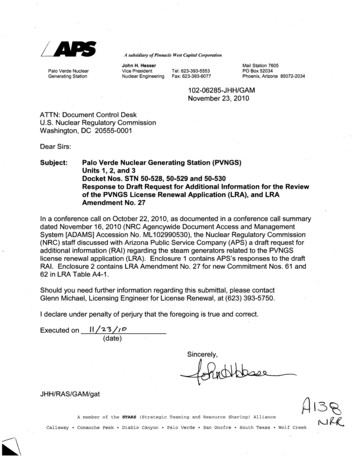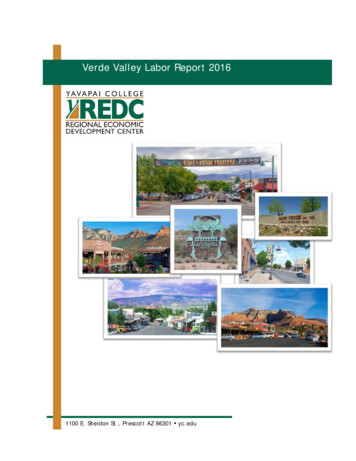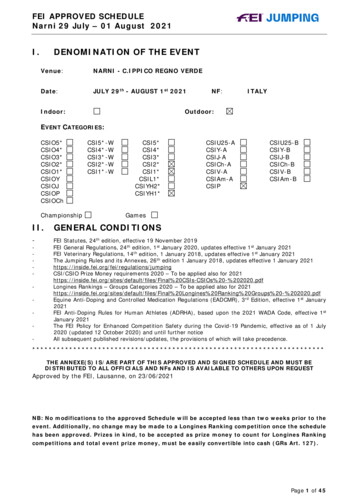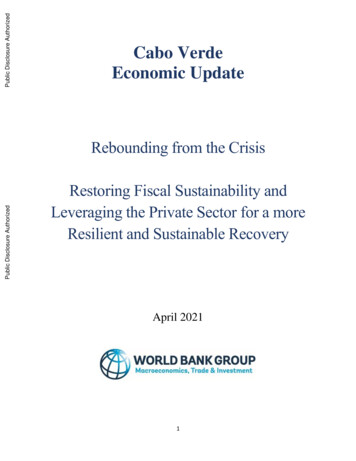
Transcription
Public Disclosure AuthorizedPublic Disclosure AuthorizedPublic Disclosure AuthorizedPublic Disclosure AuthorizedCabo VerdeEconomic UpdateRebounding from the CrisisRestoring Fiscal Sustainability andLeveraging the Private Sector for a moreResilient and Sustainable RecoveryApril 20211
Disclaimer:This report is a product of the staff of the International Bank for Reconstruction andDevelopment/The World Bank. The findings, interpretations, and conclusions expressed in thispaper do not necessarily reflect the views of the Executive Directors of The World Bank or thegovernments they represent. The World Bank does not guarantee the accuracy of the dataincluded in this work. The boundaries, colors, denominations, and other information shown onany map in this work do not imply any judgment on the part of The World Bank concerning thelegal status of any territory or the endorsement or acceptance of such boundaries.Copyright:The material in this publication is copyrighted. Copying and/or transmitting portions or all of thiswork without permission may be a violation of applicable law. The International Bank forReconstruction and Development/The World Bank encourages dissemination of its work and willnormally grant permission to reproduce portions of this work promptly.For permission to photocopy or reprint any part of this work, please send a request with completeinformation to the Copyright Clearance Center, Inc., 222 Rosewood Drive, Danvers, MA 01923,USA, telephone 978-750-8400, fax 978-750-4470, http://www.copyright.com/.All other queries on rights and licenses, including subsidiary rights, should be addressed to theOffice of the Publisher, The World Bank, 1818 H Street NW, Washington, DC 20433, USA, fax202-522-2422, e-mail pubrights@worldbank.org.2
PrefaceThe objective of this report is to provide an update to the Government of Cabo Verde, think-tanks andresearchers, and the public on the state of the Cabo Verde economy and its outlook, together with thestructural reforms required to strengthen the foundations for private sector-led recovery from the COVID19 crisis. The report begins with a chapter on recent economic developments, the medium-term outlook,and risks. It includes sections on growth, fiscal policy, public debt, the external sector, monetarydevelopments, and inflation. The second chapter stresses the importance of improving the investmentclimate to leverage the role of the private sector for an inclusive economic recovery. It provides an overviewof key challenges and actionable policy priorities around foreign direct investment, the businessenvironment, and competition.3
AcknowledgementsThis update was prepared by the Macroeconomics, Trade and Investment Global Practice under theguidance of Nathan M. Belete (Country Director, AWCF1), Theo David Thomas (Practice Manager,EAWM1) and Eneida Fernandes (Resident Representative, AWMGW). The overall effort was led by JoseDaniel Reyes (Senior Economist, EAWM1) and Rosa Delgado (Economist, EAWM1).The first chapter was authored by Jose-Daniel Reyes (Senior Economist, EAWM1) and Rosa Delgado(Economist, EAWM1), with inputs from Luiz Felipe Almeida (Consultant), Samer Naji Matta (Economist,EAWM1), Djibril Ndoye (Economist/Statistician, EAWPV), Sering Touray (Economist, EAWPV), andCassandro Mendes (Consultant, EAWM1).The second chapter was prepared by a team composed by Tania Ghossein (Senior Private sector Specialist,ETICI), Jana Krajcovicova (Private Sector Specialist, ETICI), Philippe-Armand De Bonneval (Consultant,ETICI), Antonio Baptista (Consultant, EAWF1), Graciela Miralles (Senior Economist, ETIMT), DavidaConnon (Private Sector Development Specialist, DECDP). Paula Tavares (Senior Private SectorDevelopment Specialist, DECWL), Sebastian Franco (Research Analyst, SARCE) and TheodoreAnthonioz (consultant, CAFA2) provided valuable inputs.Helpful administrative and operational assistance was provided by Jandira Dos Santos (Team Assistant,AWMCV), Edson Medina (Consultant, EAWM1), Micky O. Ananth (Operations Analyst, EAWM1),Maude Jean-Baptiste (Program Assistant, EAWM1), and Theresa Adobea Bampoe (Program Assistant,EAWM1).The report benefitted from comments provided by Markus Kitzmuller (Lead Economist and ActingProgram Leader), Ernest John Sergenti (Senior Economist, EAWM1), Cristina Navarrete (Senior PrivateSpecialist, EAWF1), and Theo David Thomas (Practice Manager, EAWM1). The peer reviewers wereEmilia Skrok (Senior Economist, EECDR), Sylvia Solf (Senior Private Sector Specialist, ETICI) and RohanLongmore (Senior Economist, ELCMU).4
ContentsPreface . 3Acknowledgements . 4List of Tables, Figures, and Boxes . 6Acronyms and Abbreviations . 7Executive Summary . 8Part I –The State of the Economy . 13Recent Developments . 13A.1.Real Sector . 132.Fiscal and Debt Dynamics . 163.Balance of Payments . 214.Monetary Policy and Inflation . 245.Poverty . 25Outlook and Risks . 27B.Part II –Special Focus: The Enabling Environment for Private Investment . 301.A Portrait of the Private Sector in Cabo Verde . 302.Foreign Direct Investment: In Pursuit of Economic Diversification . 333.Business Regulatory Environment: Slow Progress, Better Prospects . 434.Competition: Leveling the Playing Field Between Public and Private Actors. . 505.Policy Priorities: Reform Areas and Action Plan . 57References . 61Annex 1: Cabo Verde Emergency Response to the COVID-19 Crisis . 625
List of Tables, Figures, and BoxesTable 1: Contribution to GDP Growth . 15Table 2: Key Fiscal Indicators . 17Table 3: COVID-19 Additional Fiscal Financing Needs and Sources . 18Table 5: Selected Economic Indicators under Baseline and Downside Scenarios. 29Table 6. Firms, Output, and Employment in Cabo Verde . 30Table 7. Firm Characteristics, by type . 31Table 8: Proposed Action Plan. 60Figure 1: Annual Growth rates 2019-2020 . 15Figure 2: Loan Guarantees to SOEs. 19Figure 3: Capitalization to SOEs . 19Figure 4: Debt and GDP Per-Capita . 21Figure 5: Debt-to-GDP Ratio . 21Figure 6: Current Account Balance . 23Figure 7: Annual Remittances Inflows . 23Figure 8: Interest Rates . 25Figure 9: Inflation . 25Figure 10: Moderate Poverty Rates . 26Figure 11: Extreme Poverty Rates . 26Figure 12: Firms Distribution by Size. 32Figure 13: Firms Distribution by Ownership (percentage) . 32Figure 14: Firms’ Distribution by Export/Import Status (percentage) . 32Figure 15: Number of Firms with Public Capital. 32Figure 16: Labor Productivity by Export/Import Status . 32Figure 17: Labor Productivity by Ownership . 32Figure 18: The Foreign Direct Investment Lifecycle . 35Figure 19: Real GDP Growth Decomposition . 36Figure 20: Stock of FDI as a Share of GDP . 36Figure 21: FDI Inflows as a share of GDP. 36Figure 22: Market Concentration of FDI . 36Figure 23: Identification of Products with Potential to Develop Linkages with Hotels . 42Figure 24: Estimation Contribution to Value Added of Increasing Local Linkages . 42Figure 25: The Lifecycle of a Firm . 44Figure 26: Cabo Verde Ease of Doing Business: Current Score and Ranking . 45Figure 27: Cabo Verde Rankings on Doing Business Topics (1-190) . 45Figure 28: Challenging Regulations and Settling Disputes, and Contract Enforcement . 49Figure 29: Benchmarking Competition in Cabo Verde . 52Box 1: The COVID-19 Pandemic in Cabo Verde 13Box 2: Fiscal Risks in Cabo Verde: A Call for Action . 19Box 3: Debt Pressures in SIDS and Potential Patways for Development Financing . 21Box 4: Impact of the COVID-19 Crisis in the Tourism Sector. 23Box 5: The Impact of the COVID-19 crisis on Businesses in Cabo Verde . 33Box 6: Potential Opportunities for Economic Diversification . 37Box 7: Best Practices in Institutional Arrangements for Investment Policy and Promotion . 38Box 8: The Competition Commission of Mauritius (CCM) . 566
Acronyms and AbbreviationsAdSASABCVAguas de Santiago SAAutoridade Reguladora das AquisiçõesPúblicasAeroportos e Segurança AéreaBanco de Cabo VerdeCADCurrent Account DeficitCCMCompetition Commission of MauritiusCPIConsumer Price IndexCVACabo Verde AirlinesCVECabo Verdean EscudosDSSIDebt Service Suspension InitiativeARAPESAExternal Stability AssessmentEUEuropean UnionFDIForeign Direct InvestmentGCIGDPGNIGlobal Competitiveness IndexGross Domestic ProductGross National IncomeGrowth and Poverty ReductionStrategy PaperGPRSPGVCsICTIFHINEIEE-ACPM&EMoJMSMEMonitoring and EvaluationMinistry of JusticeMicro, Small, and MediumSized EnterprisesPublic Agency for InformationTechnologyNon-performing LoansOrganization for Economic Cooperation and DevelopmentOne-Stop-Service forbusinessesStrategic Plan for SustainableDevelopmentPublic and Publicly-GuaranteeNOSiOSSPEDSEconomic Community of West AfricanStatesELECTRA Empresa de Electricidade e ÁguaENAPOR Empresa Nacional de PortosExport Promotion AgencyInvestment Promotion AgencyKey Performance SSIPPSIRCSMESOESSAUNGlobal Value ChainsInformation and CommunicationsTechnologyImobiliária, Fundiária e Habital SANational Institute of StatisticsInvestment-Enabling Environment inAfrican, Caribbean and Pacificcountries7Purchasing Power ParityPublic-Private PartnershipsSociedade deDesenvolvimento Turístico dasIlhas da Boa Vista e do MaioSmall Islands DevelopingStatesSistema de InformaçãoProcessual e PenalIntegrated CommercialRegistry System SoftwareSmall and Mid-size EnterprisesState-Owned EnterpriseSub-Saharan AfricaUnited NationsUNCTAD United Nations Conference onTrade and DevelopmentUSDUnited States DollarVATWBGKPIValue-Added TaxWorld Bank GroupKey Performance Indicator
Executive SummaryThe first Economic Update for Cabo Verde focuses on the importance to return to fiscal sustainabilityin the aftermath of the COVID-19 pandemic and on the potential of the private sector to foster amore sustainable and resilient recovery, maximizing its contribution to medium-term economicgrowth. The first chapter discusses the current macroeconomic situation, outlook, and risks the countryfaces a year after the COVID-19 pandemic started. The second chapter reviews the enabling environmentto promote private investment by focusing on Foreign Direct Investment (FDI), the domestic businessenvironment, and the level of competition. The report offers a set of policy priorities for a swift return tofiscal and debt sustainability in the aftermath of the pandemic and to lay the foundations for leveraging therole of the private sector for a more sustainable and resilient economy.Chapter 1: The State of the EconomyRecent Economic DevelopmentsThe impact and persistence of the COVID-19 pandemic caused the largest economic contraction onrecord in 2020 and exposed the vulnerabilities of Cabo Verde’s growth model. The development modelis characterized by an overreliance in tourism, large presence of the government in the economy, and bigFDI flows directed to all-inclusive hotels with little connection to other sectors of the economy. Prior to thecrisis, Cabo Verde experienced robust and accelerating economic growth on the back of a thriving tourismsector and strong structural reforms. These included State-Owned Enterprise (SOE) reforms, and fiscalrestraint to reduce the high levels of public sector debt. The crisis reversed progress on fiscal consolidationand debt reduction made over the last five years. Gross Domestic Product (GDP) contracted by 14.8 percentin 2020 (15.7 percent in per-capita terms), one of the largest reductions in Sub-Saharan Africa (SSA). Onthe demand side, net exports were a drag on growth, with a reduction of 75 percent in tourism arrivals. Thetourism sector, which contracted by 71 percent, represents 25 percent of GDP, generates 23 percent offormal jobs, and accounts for 55 percent of overall exports of goods and services. All sectors of the economycontracted, except for the financial sector, construction, and public administration.The crisis reversed the progress in poverty reduction achieved since 2015, putting around 100,000people into temporary poverty. Cabo Verde witnessed significant poverty reduction over the last decade.Using the national poverty line equivalent to US 5.4 in purchasing power parity (PPP) terms per personper day in 2015 prices, the incidence of poverty was projected to reach 26 percent in 2020. Extreme poverty,defined as those below the national food poverty line (PPP US 2.9 per person in 2015), was expected to be6 percent. The crisis increased the national (extreme) poverty rate to 45 (20) percent in the short-term. Withthe progressive resumption of economic growth, the national (extreme) poverty rate is projected to fall to34 (10) percent in 2022. Because women are the majority of informal workers, domestic employees, andlabor in the tourism sector they are more likely to fall into poverty as a result of the crisis.Despite very limited policy buffers, the authorities rapidly implemented measures to contain andmitigate the health and economic impact of the pandemic. These measures included declaring a state ofemergency for the first time in Cabo Verde’s history, boosting cash transfers to vulnerable households,granting temporary tax exemptions, and deferring tax payments, and providing credits and guarantees tosmall businesses (Annex 1). On top of these temporary support and containment measures, the Governmentdeveloped a comprehensive recovery plan entitled Cabo Verde Ambition 2030 that seeks to achievesustainable development and increase resilience to shocks. The strategy delineates programs to (i)8
reestablish confidence in the health and safety conditions, (ii) recover and expand the tourism sector, and(iii) operationalize the concept of a ‘Hub in the mid-Atlantic’, which aims at transforming the country in alogistic and transport hub connecting Europe, North and South America, and Africa.The crisis led to a significant increase in the fiscal deficit. Driven mainly by the impact of the crisis ontax collection, fiscal revenue declined by 23.8 percent in nominal terms, reaching 25.8 percent of GDP in2020. To respond to urgent needs brought on by the pandemic, the government increased currentexpenditure and reduced capital investment, keeping total public expenditure broadly stable in nominalterms. As a result, the overall deficit (including grants) increased from 1.8 percent in 2019, to 8.9 percentin 2020. Consequently, fiscal financing needs for 2020 increased from an expected US 87.6 million (4percent of GDP) before the crisis to US 176.8 million (10 percent of GDP) after the crisis. They were fullycovered by concessional credits, grants, domestic borrowing, and resources freed up by the Debt ServiceSuspension Initiative (DSSI).1Consequently, hard won gains in reducing the public debt burden over the last 4 years were erased,raising the urgency of measures to increase debt transparency. Public debt had been on a declining pathsince 2017, falling from 128.4 percent of the GDP in 2016 to 124.9 percent in 2019. Debt reached 151.3percent of GDP in 2020. Public and Publicly-Guarantee (PPG) debt is assessed as sustainable, but the riskof external and total debt distress is high, according to the latest joint World Bank/IMF Debt SustainabilityAssessment, conducted in September 2020. Increasing debt transparency by broadening the coverage ofpublic debt to include guaranteed domestic debt and non-guaranteed debt held by SOEs is crucial to depicta more comprehensive situation of public and publicly guarantee debt in the country, which is essential toimprove the management of fiscal risks.The crisis negatively impacted the financial performance of an already weak SOE sector, whichrequired emergency fiscal support, exacerbating fiscal risks. The authorities extended loan guaranteesamounting to US 54.1 million to support financially distressed SOEs. Cabo Verde Airlines (CVA),partially privatized in 2019 and grounded since March 2020, received loan guarantees of US 25.6 millionin 2020 (and US 20.2 million so far in 2021). Capitalizations of SOEs accounted for US 7.8 million, withNEWCO (the Special Purpose Vehicle created to absorb CVA’s debt before privatization) the largestrecipient with US 5.6 million. The poor financial performance of the SOE sector in 2020 will negativelyimpact future fiscal balances through two channels: (i) through additional financial support in the form oftransfers or capitalizations that may be required to return SOEs to financial sustainability and (ii) throughthe realization of contingent liabilities, primarily loan and minimum revenue guarantees in the aviation andmaritime sectors. These fiscal vulnerabilities may undermine Cabo Verde’s efforts to restore fiscalsustainability and return debt (as a share of GDP) to a declining trajectory.Outlook and risksThe economy is likely to recover slowly from the pandemic, but the outlook is highly uncertain withsubstantial downside risks. Real GDP growth is projected at 3.9 percent in 2021, gradually acceleratingto 6.1 percent by 2023, with GDP per capita only expected to return to its 2019 level by 2024. In the shortterm, the recovery will be driven by a gradual reactivation of the tourism sector, which is highly dependenton the success of the vaccine programs in both the major tourist markets and in Cabo Verde. Over the1The DSSI is an initiative of the G20 group to help countries cope with the fallout of the COVID-19 crisis. It offereda temporary suspension of official sector debt payments, with repayment period of five years and a one-year graceperiod. The DSSI was approved in April 2020 for eight months, it was subsequently extended until June 2021.9
medium-term, structural reforms will need to promote private consumption and investment in tourism andthe blue economy, energy and ICT to help to close the output gap, with the resumption of FDI to unlockproductivity. Uncertainties regarding the duration of the pandemic (including the rise of new COVID-19variants), implementation of the vaccination campaign (including people refusing to be vaccinated), andthe speed of the global recovery (particularly in Europe) cloud medium-term prospects. The country alsoremains significantly exposed to climate-related shocks.The key policy priorities to restore fiscal and debt sustainability in the aftermath of the crisis are:Policy PrioritiesReturn to a prudent fiscal policy stanceAdvance revenue-enhancing reforms such as recovering outstanding tax arrears through stricterenforcement mechanisms and strengthening tax monitoring to enhance compliance through tax audits,inspections, and improved tax administration and controls mechanisms at customs.Prioritize health expenditures and capital expenditures, while containing current expenditures andenhancing the management of the public investment program to ensure fiscal sustainability.Revamp the management of fiscal risks by improving the reporting of SOE finances, quantify fiscalrisks, particularly those arising from contingent liabilities, and institutionalize oversight for fiscal riskmanagement at the Ministry of Finance.Improve debt management and transparencyContinue to implement a zero limit on non-concessional borrowing.TimelineSTSTST MTSTPublish and improve the content of the quarterly SOE bulletins, by including an assessment of fiscalrisks.STIncrease debt transparency by broadening the coverage of public debt to include guaranteed domesticdebt and non-guaranteed debt held by SOEs.Reinvigorate structural policy reformsReinvigorate structural reforms of SOEs by bringing private sector into the airport managementcompany and the electricity utility company to improve efficiency and service delivery.MTMTChapter 2: The Enabling Environment for Private InvestmentThe impact and persistence of the pandemic has had a large negative effect on firm performance.Given the concentration of firms and jobs in the services sector, particularly in tourism and accessoryactivities, the demand shock created by the abrupt and persistent global shut down of tourism negativelyimpacted firms and workers in Cabo Verde. Recognizing these challenges, the Cabo Verde Ambition 2030plan assigns a foundational role to the private sector to promote a sustainable and resilient economicrecovery. To contribute to identification of key policy priorities to achieve this goal, this chapter focuseson FDI, business regulations, and competition policy.Foreign Direct InvestmentThe institutional framework for FDI policy in Cabo Verde is broadly aligned with good globalpractices, but policy implementation is fragmented. The absence of an FDI strategy that builds on theCabo Verde Ambition 2030 strategy to recovery from the COVID-19 crisis will prevent an efficient andcoordinate implementation of policies during the recovery phase. A strategy that identifies priority sectors10
and tasks within efficient Global Value Chains (GVCs) is needed, without trying to determine particularinvestments. Clarification of the roles and responsibilities in policy implementation across differentagencies as well as the promotion of mechanisms to allow communication between stakeholders(government agencies, the private sector, and civil society) is crucial to increase the effectiveness ofinvestment policy.Strengthening the Investment Promotion Agency (Cabo Verde Trade Invest) to effectively implementthe FDI policy is critical. The agency’s mandate to attract FDI needs to be updated in four areas. First, arevamped corporate strategy in support of national investment objectives. Second, enough budget andhuman resources should be dedicated to implement the strategy. Third, a direct and clear reporting line tothe Ministry of Finance should be established, to ensure adequate oversight over their activities and ensurevalue for money and risk management. Finally, expanding and improving the quality of services that theagency offers to investors, particularly after-care services, is critical.The creation of linkages between domestic suppliers and hotel chains, particularly in the agriculturaland fishery sectors, is important to maximize the development impact of FDI. Connecting localsuppliers, particularly in the agriculture and fishing sectors, with hotels would promote knowledge transfersand, as a result, improve the productivity of local firms. A task force could be created to delineate andimplement a comprehensive set of interventions to increase FDI spillovers to domestic firms.Business Regulatory EnvironmentThe simplification of rules and regulations for licenses and permits would facilitate firms’ entry intomarkets and level the playing field by ensuring a stable business environment. A stocktaking ofrequired licenses in the strategic sectors of tourism and logistics is needed to identify unnecessary licensesor procedures that do not meet the criteria of necessity, legality, and business friendliness. Additionally,allowing for greater flexibility in the definition or change of business activities would allow businesses toadapt more easily to changing market needs, especially during the COVID-19 crisis and the recovery period,making it easier to adapt without resorting to burdensome licensing requirements.To help businesses significantly hit by the crisis, the authorities can accelerate reforms aimed atimproving access to finance. Efforts should be made to modernize and operationalize the collateral registryand support the development of insolvency procedures, through training and communications campaigns.Functioning insolvency procedures would help struggling entrepreneurs and companies liquidate theirholdings and get back into the economy with new ventures.Further efforts are also needed to support on digitalization, feedback mechanisms, andprofessionalization of the public procurement. Enhancing the capabilities of the e-procurement systemis a priority, including bid evaluation, communication with suppliers, award, signature, and payment. Thisreform is particularly relevant in a fragment market structure as is the case in Cabo Verde.CompetitionCabo Verde should continue with the process of reforming its competition law, paying specialattention to prevent abuse of dominant positions. Merger notification thresholds should be revised torely on criteria that are quantitative and objective at the individual and aggregate levels to provide clarityto firms participating in a merger or acquisition. Policymakers are encouraged to reconsider existingexempt
researchers, and the public on the state of the Cabo Verde economy and its outlook, together with the structural reforms required to strengthen the foundations for private sector-led recovery from the COVID-19 crisis. The report begins with a chapter on recent economic developments, the medium-term outlook, and risks.


